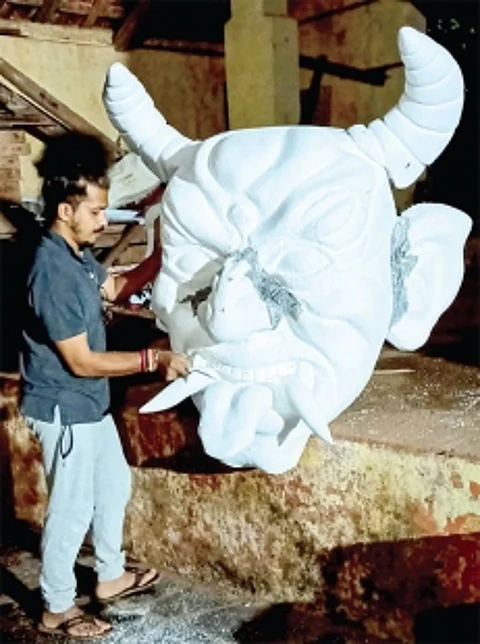

Narakchaturdashi is observed throughout India, however, the practice of burning Narkasur effigies at dawn to usher in Diwali is special to Goa. With months of planning and the creativity of the youngsters to make these effigies of Narakasura, it is saddening to see their talent reduce to ashes by sunrise. However, this does not curb their enthusiasm to outdo themselves for the next year’s celebrations. The legend of celebrating Narakasura in Goa has been continued from generation to generation and the main aim behind the story is the victory of good over evil.
Narakchaturdashi is celebrated to mark
Lord Krishna’s victory over the demon Narkasur and Goa does it the best with
terrifying yet amazing creations by Goan talent. They first start with the
mould of the face of the Narkasur and then the wire frame of the body. The more
senior members of the group, which usually comprise of college students or
working men, find time only from 6pm to 12am to work on Narkasur, while the
younger school going children take advantage of their Diwali vacations to lend
a helping hand. The excitement builds up during the last two days of the
festival. The ambience of making the Narkasur is special for the youngsters of
this group as they have seen their elders make Narkasur for years before they
took up the reins.
Sagar Naik Mule from Adpai is an expert when it comes to working
on the face of the Narkasur. He is one of the most sought artist to give a
terrifying and grimaced look on the face of the demon. “This year, I’m working
on one mask which will be around three feet tall. This is one of the best
platforms for all artists to showcase their talent and skills. If the artists
are skilled and famous, then they have more respect and demand during this
period. I enjoy working on Narkasurs as every year is a new birth for a new
artist and a new Narkasur as well. I do not stick with one group because I
always want to do a fresh body of work each year. During that particular period
of time, I teach others how to do work, so they also learnt the techniques,”
says Sagar.
Effigies of Narakasuras filled with grass and crackers are burnt
at around 4am symbolising the end of evil. Diwali marks a new year as the
houses are cleaned and decorated with ‘akash kandil’, small lamps, mango leaves
and marigold flowers.
Diwali
is not a one day festival; it is celebrated till Tulsi Vivah and lamps are lit
every evening. The other celebrations during these days include Lakshmi puja on
Diwali day, ‘Padvo’, a cow puja ritual of cattle worship on Balipratipada day,
‘Bhaubeej’, and Tulsi Vivah.